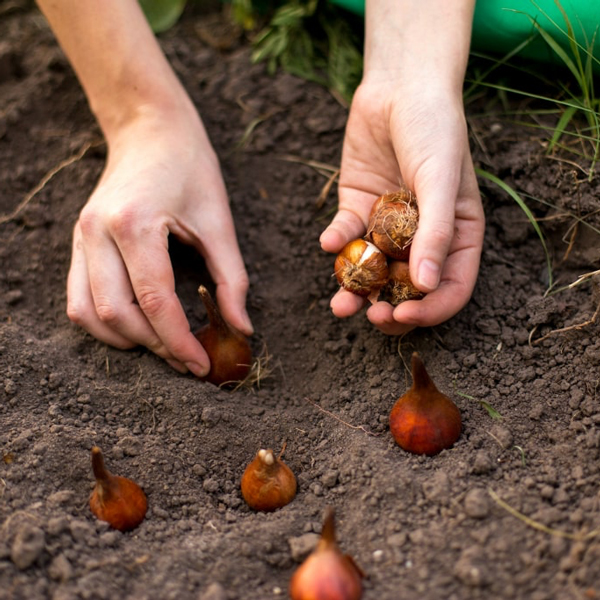By Barbara Whitaker, NYTimes.com
In the last 11 years Judy Glattstein has planted more than 40,000 spring-flowering bulbs on her 9-acre property in Frenchtown, N.J., near the Delaware River.
“Bulbs are flowers in a package,” said Ms. Glattstein, a gardening consultant and author. “You get these little lumpy things, you put them in the ground in the fall, and you have faith winter is going to pass, spring is going to come and these are going to bloom. Isn’t it a wonderful thing?”
Of course, there are a few considerations to keep in mind when planting bulbs — from pesky squirrels, which have a knack for digging them up as fast as they are planted, to hungry deer that feast on flowering tulips in the spring. Making smart bulb selections and paying attention to details like planting schedules and conditions can help guarantee success.
According to Tim Schipper, owner of Colorblends, a wholesale mail-order bulb company in Bridgeport, Conn., the optimum soil temperature for planting bulbs is about 55 degrees. And with all the unseasonably warm weather across the region this fall, gardeners may be questioning whether they should go ahead and plant.
Mark Bridgen, director of Cornell University’s Long Island Horticultural Research and Extension Center in Riverhead, N.Y., sees it as an advantage. “The warm weather should help because it gives you more time to plant,” he said.
Ms. Glattstein, whose books include “Flowering Bulbs for Dummies” (IDG Books Worldwide, 1998) and “Bulbs for Garden Habitats” (Timber Press, 2005), said she intended to hold off putting in tulips until November or December because the warm weather might confuse the bulbs. But she said she was planting daffodils, hyacinths and other smaller bulbs.
“The rule of thumb for bulbs is the smaller the bulb, the sooner it must be planted,” she said.
The reality, however, is that bulbs are typically very forgiving. If placed in the ground at the specified depth, they will do their best to come up — even if buried upside down or sideways.
It’s best to concentrate on buying quality bulbs and planting them in a place where there is good drainage and proper sunlight, with a little consideration of the pests in your area.
Though deer love tulips, they tend to steer clear of several types of spring flower bulbs, like daffodils, grape hyacinths, Crocus tommasinianus and snowdrops. They also show little interest in less common choices like starflower (Ipheion uniflorum), snake’s head (Fritillaria meleagris) and blue camassia.
If squirrels are the problem, Ms. Glattstein suggests a little subterfuge. Put mulch over freshly planted bulbs, so they can’t see the disturbed soil. “They never dig up old bulbs,” she said.
Or, when pruning roses, place the canes over the bulbs. Squirrels don’t like to get stuck by thorns either.
Colorblends specializes in putting together bulb mixes that complement each other. Like other mail-order operations based in Connecticut, including Van Engelen and its sister company John Scheepers in Bantam and White Flower Farm in Litchfield, it puts out color catalogs that provide a wealth of information about bulbs and their growing requirements.
For example, it’s important to know that in our region tulips often do not come back every year.
“Tulips really aren’t suitable for our climate,” Ms. Glattstein said. “If you want success with tulips, just plant new ones every year or plant ones that have a tendency to come back.” Midseason Darwin hybrids are an example.
But many spring flowering bulbs will come back year after year, if left to their own devices. A key to fostering their return is to allow the foliage to wither on the plant. It may not look pretty, but it provides important nutrients to the bulb.
As for selecting the actual bulbs, Ms. Glattstein said she approaches it much like buying produce. “If you can pick a good onion at the grocery store, you can pick a good bulb,” she said.
Although bulbs vary in size, look for ones that are large for their variety, and firm, with a nice weight for their size. If they are mushy or desiccated, steer clear. Some bulbs have a papery tunic — don’t remove it.
Buying from companies that import directly from the Netherlands can help assure that bulbs have been handled under optimum conditions and that they are fresh. Mr. Schipper said his company receives all its bulbs in refrigerated containers from the Netherlands beginning in August. They are then stored in a temperature-controlled warehouse until orders — 8 to 10 million bulbs annually — are shipped out beginning the first day of fall.
In its catalog, Colorblends offers tips on calculating how many bulbs you need. There’s also a section on how to plant 100 bulbs in under 30 minutes: Excavate an area five feet square and seven inches deep (15 minutes), placing the removed soil on a piece of plywood or cardboard; spread the bulbs evenly with their tips up (5 minutes); and slide the soil back over the bulbs, tamping it down lightly (10 minutes).
The most important thing, Ms. Glattstein said, is just to get your bulbs in the earth — anytime before the ground freezes.
Once the planting is done, it’s in nature’s hands. With any luck, there won’t be a repeat of last winter, when abnormally high temperatures lingered right up to New Year’s Day and buds started to push up before the ground froze, ultimately stunting the flowers.
“If we get a winter that’s really warm and long,” Mr. Bridgen at Cornell said, “that could be a problem.”








